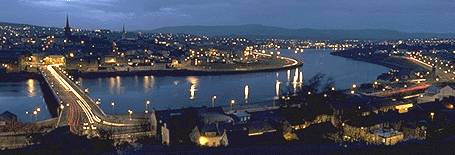 City
of Derry
City
of Derry
Original Official Site of the Northern Ireland Tourist Board

Across the sinuous River Foyle
'And now the walls of Derry rise out of history'
The story of Derry is a long and tumultuous one. Set on a hill on the banks of the Foyle estuary, strategically close to the open sea, it came under siege and attack for over a thousand years.
St Columb came out of Donegal to escape the plague 1,400 years ago and founded his first monastery in the oak grove (Doire in Gaelic), a gift from his cousin, Prince of Aileach. It was a holy place. The saint said that 'the angels of God sang in the glades of Derry and every leaf held its angel.'
You can walk along the great 17th-century walls, about a mile round and 18 feet thick, which withstood several sieges and even today are unbroken and complete, with old cannon still pointing their black noses over the ramparts. The great siege lasted for 105 days.
The modern city preserves the 17th-century layout of four main streets radiating from the Diamond to four gateways - Bishop's Gate, Ferryquay Gate, Shipquay Gate and Butcher's Gate. Historic buildings within the walls include the 1633 Gothic cathedral of St Columb. In the porch is an inscription:
'If stones could speake then London's prayse should sound Who built this church and cittie from the grounde.'
At the time of the plantation of Ulster, the City of London sent master-builders and money to rebuild the ruined medieval town hence the name Londonderry.
Colonel Baker, a governor of the city who died on the 74th day of the siege, shares a memorial in the cathedral with Captain Browning who was killed as his ship Mountjoy broke the boom across the river and relieved the city in July 1689. The chapterhouse displays the keys to the gates that were shut against James II in December 1688.
The Guildhall, looking much like its counterpart in London, is just outside the walls. Its stained glass windows illustrate almost every episode of note in the city's history. The story flows up the staircase and floods all the chambers with brilliant light.
The main thoroughfare, Shipquay Street, is very steep, with narrow little streets running off it and a craft village tucked in behind the O'Doherty tower. From the quay behind the Guildhall hundreds of thousands of Irish emigrants sailed to a new life in the New World.
County Londonderry Overview | Exploring Derry | History of Derry | Sperrin Mountains
Northern Ireland Homepage | Travel Tips | Golf | Industrial Heritage | Walking, Hiking & Horseback | Activities | Calendar of Events | Transportation | Cuisine and Restaurants | Birdwatching | Fishing | Ancestral Heritage | County Antrim | County Armagh | City of Belfast | County Down | County Fermanagh | County Londonderry | County Tyrone | Tour Operators | InterKnowledge Home Page
